Management Accounting Report: Costing Techniques and Planning Tools
VerifiedAdded on 2021/01/01
|20
|4967
|346
Report
AI Summary
This report delves into the core concepts of management accounting, providing a detailed analysis of costing techniques and planning tools. The report begins by calculating costs using both marginal and absorption costing methods, preparing income statements for three consecutive years. It highlights the differences in net profit calculations under these two methods, explaining the reasons for variances. Furthermore, the report explores various planning tools used in management accounting, particularly focusing on budgetary tools and their implications in preparing and forecasting budgets. The report also investigates how management accounting aids organizations in addressing financial challenges, leading to sustainable success. The analysis includes income statements, cost calculations, and explanations of key concepts, offering a comprehensive overview of management accounting principles.
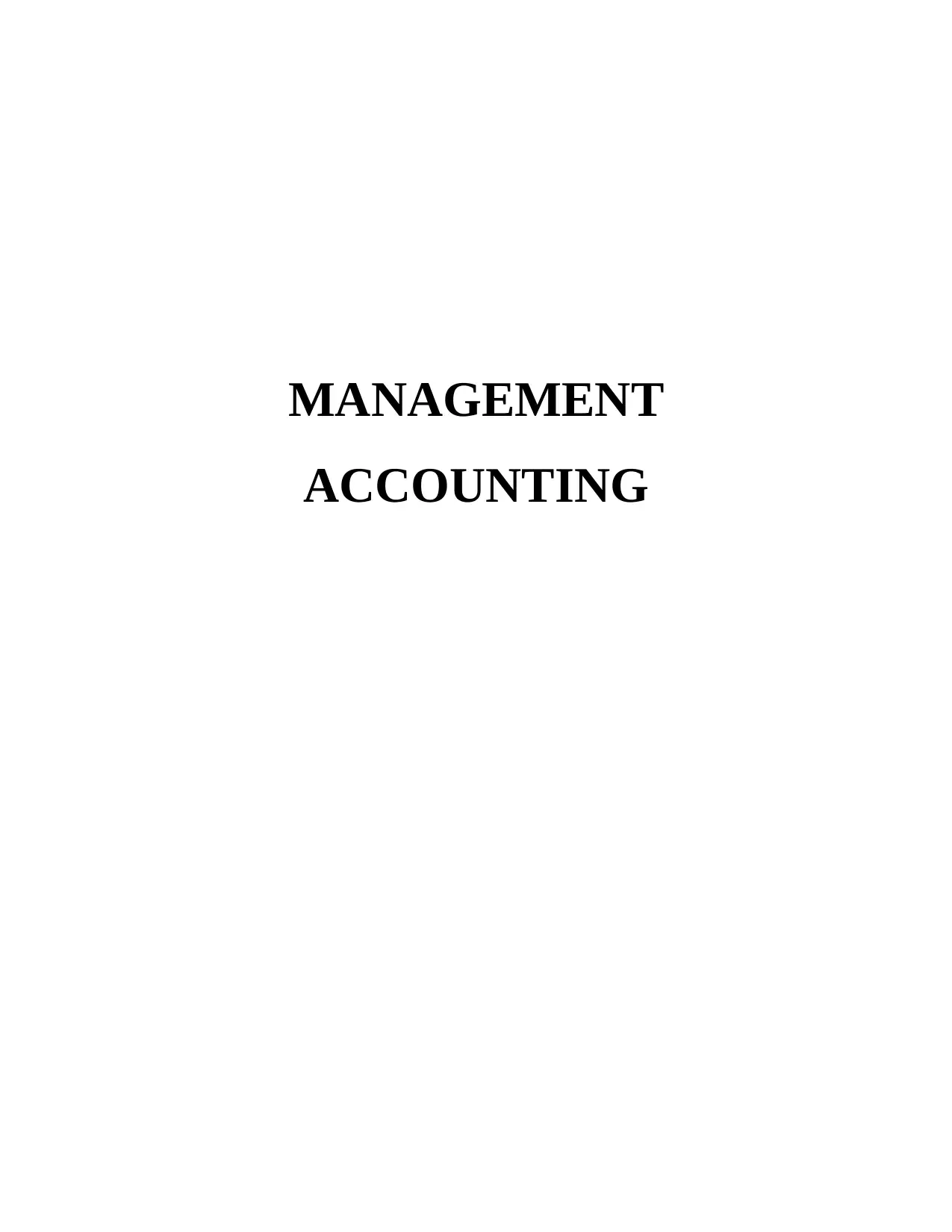
MANAGEMENT
ACCOUNTING
ACCOUNTING
Paraphrase This Document
Need a fresh take? Get an instant paraphrase of this document with our AI Paraphraser
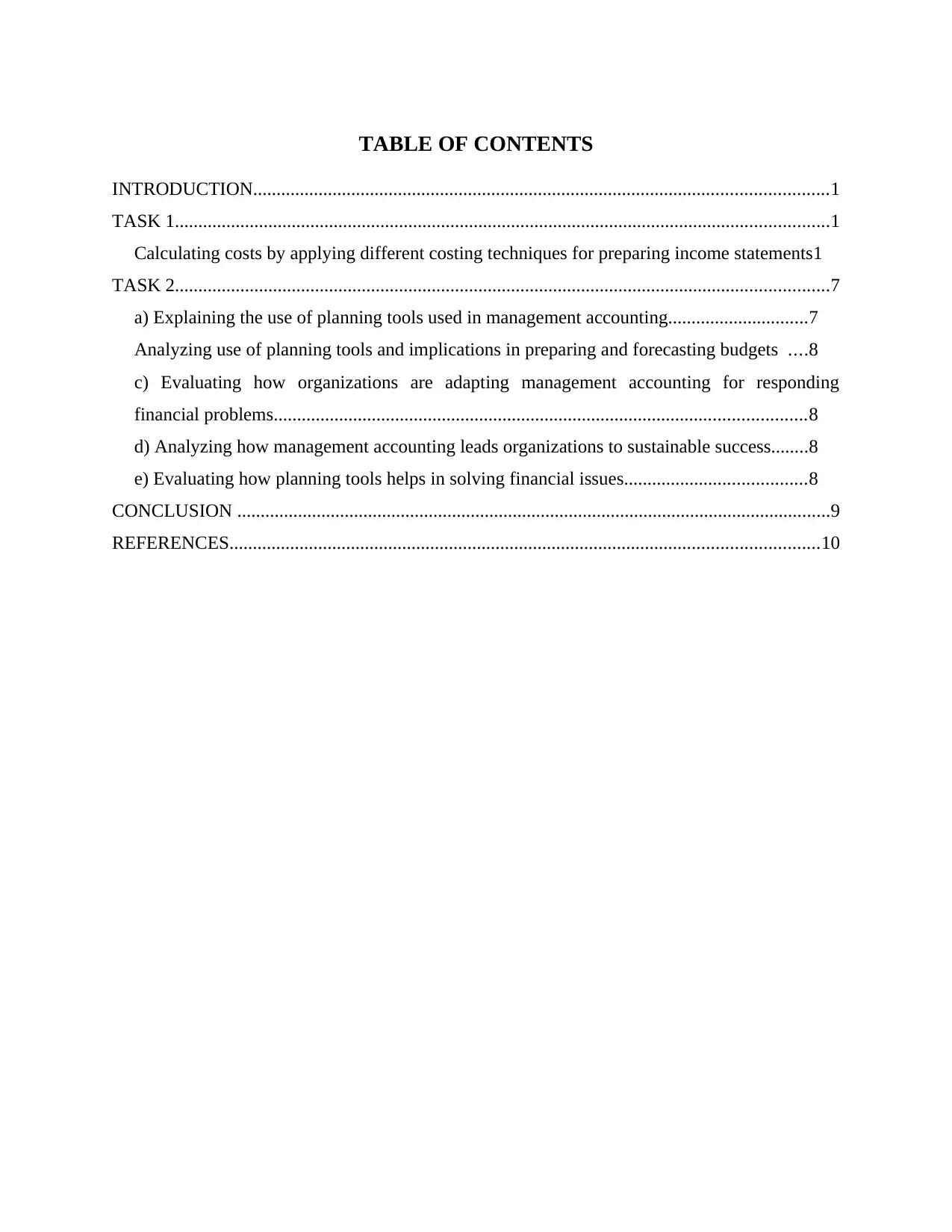
TABLE OF CONTENTS
INTRODUCTION...........................................................................................................................1
TASK 1............................................................................................................................................1
Calculating costs by applying different costing techniques for preparing income statements1
TASK 2............................................................................................................................................7
a) Explaining the use of planning tools used in management accounting..............................7
Analyzing use of planning tools and implications in preparing and forecasting budgets ....8
c) Evaluating how organizations are adapting management accounting for responding
financial problems..................................................................................................................8
d) Analyzing how management accounting leads organizations to sustainable success........8
e) Evaluating how planning tools helps in solving financial issues.......................................8
CONCLUSION ...............................................................................................................................9
REFERENCES..............................................................................................................................10
INTRODUCTION...........................................................................................................................1
TASK 1............................................................................................................................................1
Calculating costs by applying different costing techniques for preparing income statements1
TASK 2............................................................................................................................................7
a) Explaining the use of planning tools used in management accounting..............................7
Analyzing use of planning tools and implications in preparing and forecasting budgets ....8
c) Evaluating how organizations are adapting management accounting for responding
financial problems..................................................................................................................8
d) Analyzing how management accounting leads organizations to sustainable success........8
e) Evaluating how planning tools helps in solving financial issues.......................................8
CONCLUSION ...............................................................................................................................9
REFERENCES..............................................................................................................................10
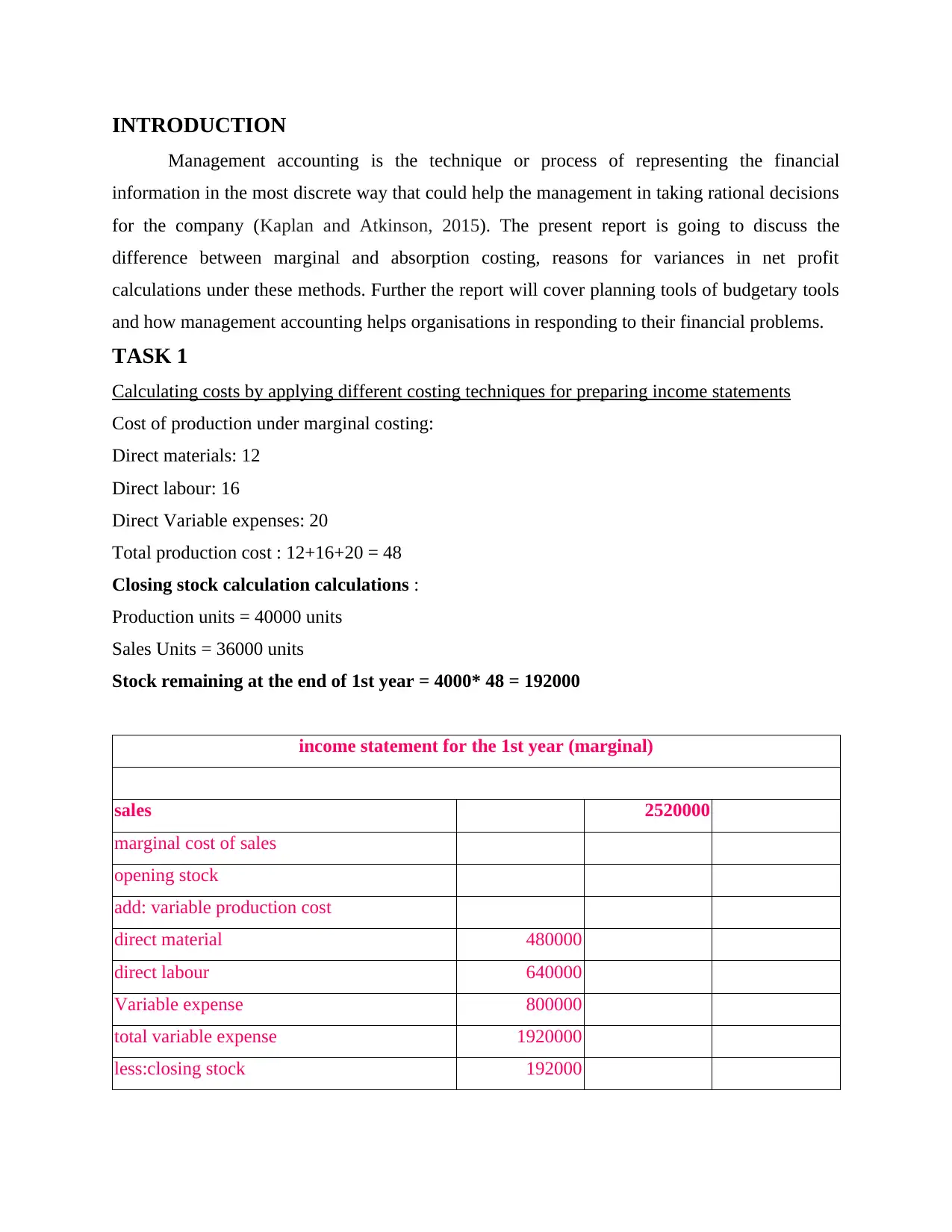
INTRODUCTION
Management accounting is the technique or process of representing the financial
information in the most discrete way that could help the management in taking rational decisions
for the company (Kaplan and Atkinson, 2015). The present report is going to discuss the
difference between marginal and absorption costing, reasons for variances in net profit
calculations under these methods. Further the report will cover planning tools of budgetary tools
and how management accounting helps organisations in responding to their financial problems.
TASK 1
Calculating costs by applying different costing techniques for preparing income statements
Cost of production under marginal costing:
Direct materials: 12
Direct labour: 16
Direct Variable expenses: 20
Total production cost : 12+16+20 = 48
Closing stock calculation calculations :
Production units = 40000 units
Sales Units = 36000 units
Stock remaining at the end of 1st year = 4000* 48 = 192000
income statement for the 1st year (marginal)
sales 2520000
marginal cost of sales
opening stock
add: variable production cost
direct material 480000
direct labour 640000
Variable expense 800000
total variable expense 1920000
less:closing stock 192000
Management accounting is the technique or process of representing the financial
information in the most discrete way that could help the management in taking rational decisions
for the company (Kaplan and Atkinson, 2015). The present report is going to discuss the
difference between marginal and absorption costing, reasons for variances in net profit
calculations under these methods. Further the report will cover planning tools of budgetary tools
and how management accounting helps organisations in responding to their financial problems.
TASK 1
Calculating costs by applying different costing techniques for preparing income statements
Cost of production under marginal costing:
Direct materials: 12
Direct labour: 16
Direct Variable expenses: 20
Total production cost : 12+16+20 = 48
Closing stock calculation calculations :
Production units = 40000 units
Sales Units = 36000 units
Stock remaining at the end of 1st year = 4000* 48 = 192000
income statement for the 1st year (marginal)
sales 2520000
marginal cost of sales
opening stock
add: variable production cost
direct material 480000
direct labour 640000
Variable expense 800000
total variable expense 1920000
less:closing stock 192000
⊘ This is a preview!⊘
Do you want full access?
Subscribe today to unlock all pages.

Trusted by 1+ million students worldwide
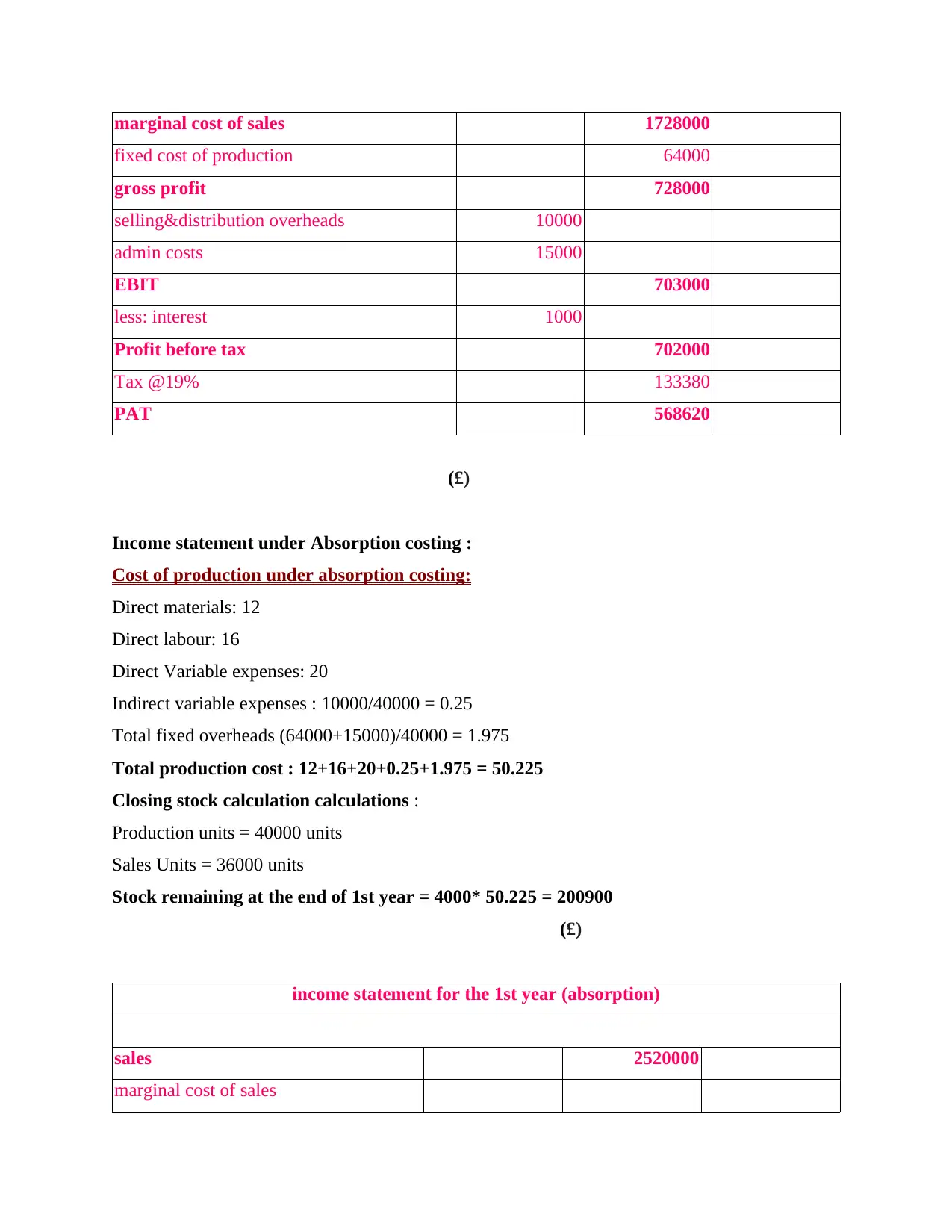
marginal cost of sales 1728000
fixed cost of production 64000
gross profit 728000
selling&distribution overheads 10000
admin costs 15000
EBIT 703000
less: interest 1000
Profit before tax 702000
Tax @19% 133380
PAT 568620
(£)
Income statement under Absorption costing :
Cost of production under absorption costing:
Direct materials: 12
Direct labour: 16
Direct Variable expenses: 20
Indirect variable expenses : 10000/40000 = 0.25
Total fixed overheads (64000+15000)/40000 = 1.975
Total production cost : 12+16+20+0.25+1.975 = 50.225
Closing stock calculation calculations :
Production units = 40000 units
Sales Units = 36000 units
Stock remaining at the end of 1st year = 4000* 50.225 = 200900
(£)
income statement for the 1st year (absorption)
sales 2520000
marginal cost of sales
fixed cost of production 64000
gross profit 728000
selling&distribution overheads 10000
admin costs 15000
EBIT 703000
less: interest 1000
Profit before tax 702000
Tax @19% 133380
PAT 568620
(£)
Income statement under Absorption costing :
Cost of production under absorption costing:
Direct materials: 12
Direct labour: 16
Direct Variable expenses: 20
Indirect variable expenses : 10000/40000 = 0.25
Total fixed overheads (64000+15000)/40000 = 1.975
Total production cost : 12+16+20+0.25+1.975 = 50.225
Closing stock calculation calculations :
Production units = 40000 units
Sales Units = 36000 units
Stock remaining at the end of 1st year = 4000* 50.225 = 200900
(£)
income statement for the 1st year (absorption)
sales 2520000
marginal cost of sales
Paraphrase This Document
Need a fresh take? Get an instant paraphrase of this document with our AI Paraphraser
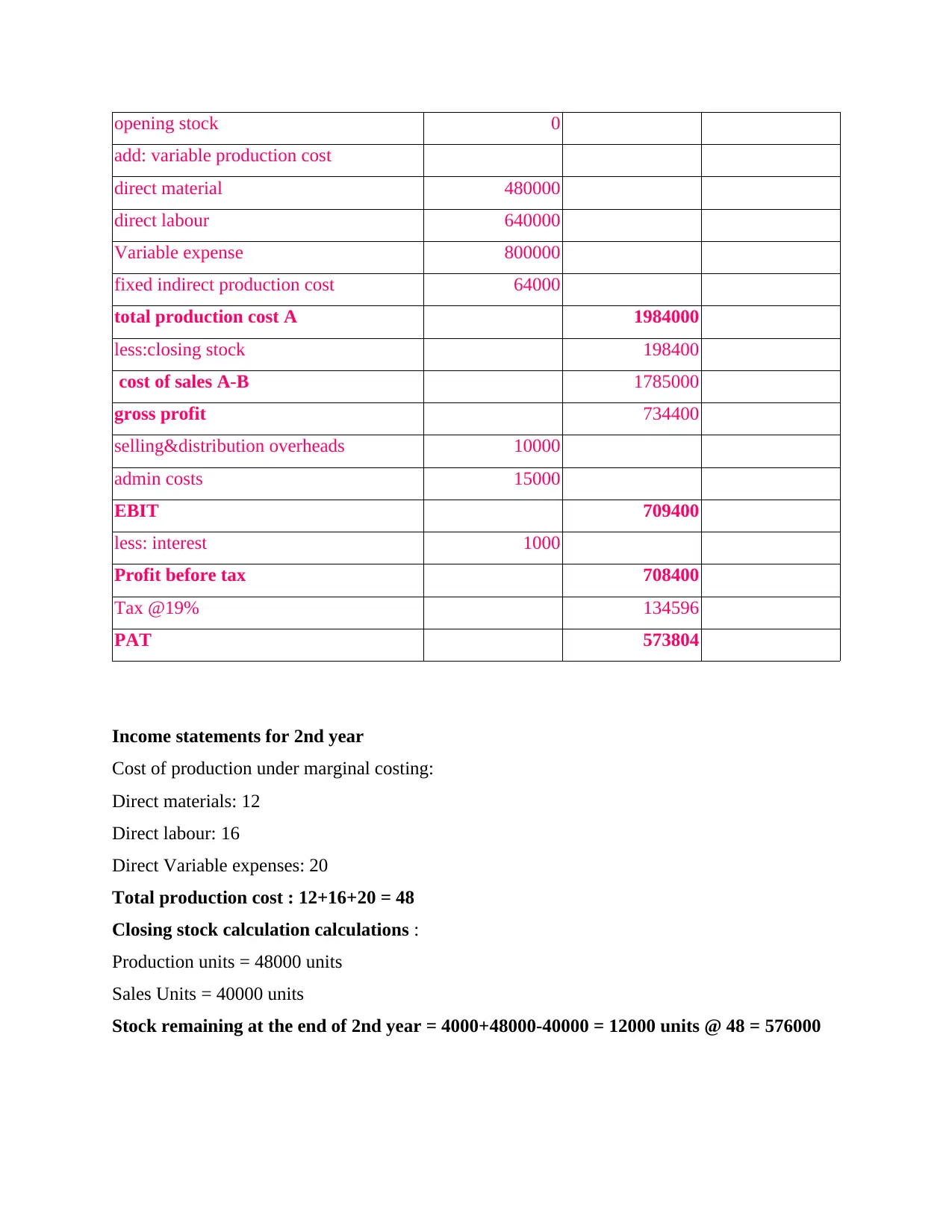
opening stock 0
add: variable production cost
direct material 480000
direct labour 640000
Variable expense 800000
fixed indirect production cost 64000
total production cost A 1984000
less:closing stock 198400
cost of sales A-B 1785000
gross profit 734400
selling&distribution overheads 10000
admin costs 15000
EBIT 709400
less: interest 1000
Profit before tax 708400
Tax @19% 134596
PAT 573804
Income statements for 2nd year
Cost of production under marginal costing:
Direct materials: 12
Direct labour: 16
Direct Variable expenses: 20
Total production cost : 12+16+20 = 48
Closing stock calculation calculations :
Production units = 48000 units
Sales Units = 40000 units
Stock remaining at the end of 2nd year = 4000+48000-40000 = 12000 units @ 48 = 576000
add: variable production cost
direct material 480000
direct labour 640000
Variable expense 800000
fixed indirect production cost 64000
total production cost A 1984000
less:closing stock 198400
cost of sales A-B 1785000
gross profit 734400
selling&distribution overheads 10000
admin costs 15000
EBIT 709400
less: interest 1000
Profit before tax 708400
Tax @19% 134596
PAT 573804
Income statements for 2nd year
Cost of production under marginal costing:
Direct materials: 12
Direct labour: 16
Direct Variable expenses: 20
Total production cost : 12+16+20 = 48
Closing stock calculation calculations :
Production units = 48000 units
Sales Units = 40000 units
Stock remaining at the end of 2nd year = 4000+48000-40000 = 12000 units @ 48 = 576000
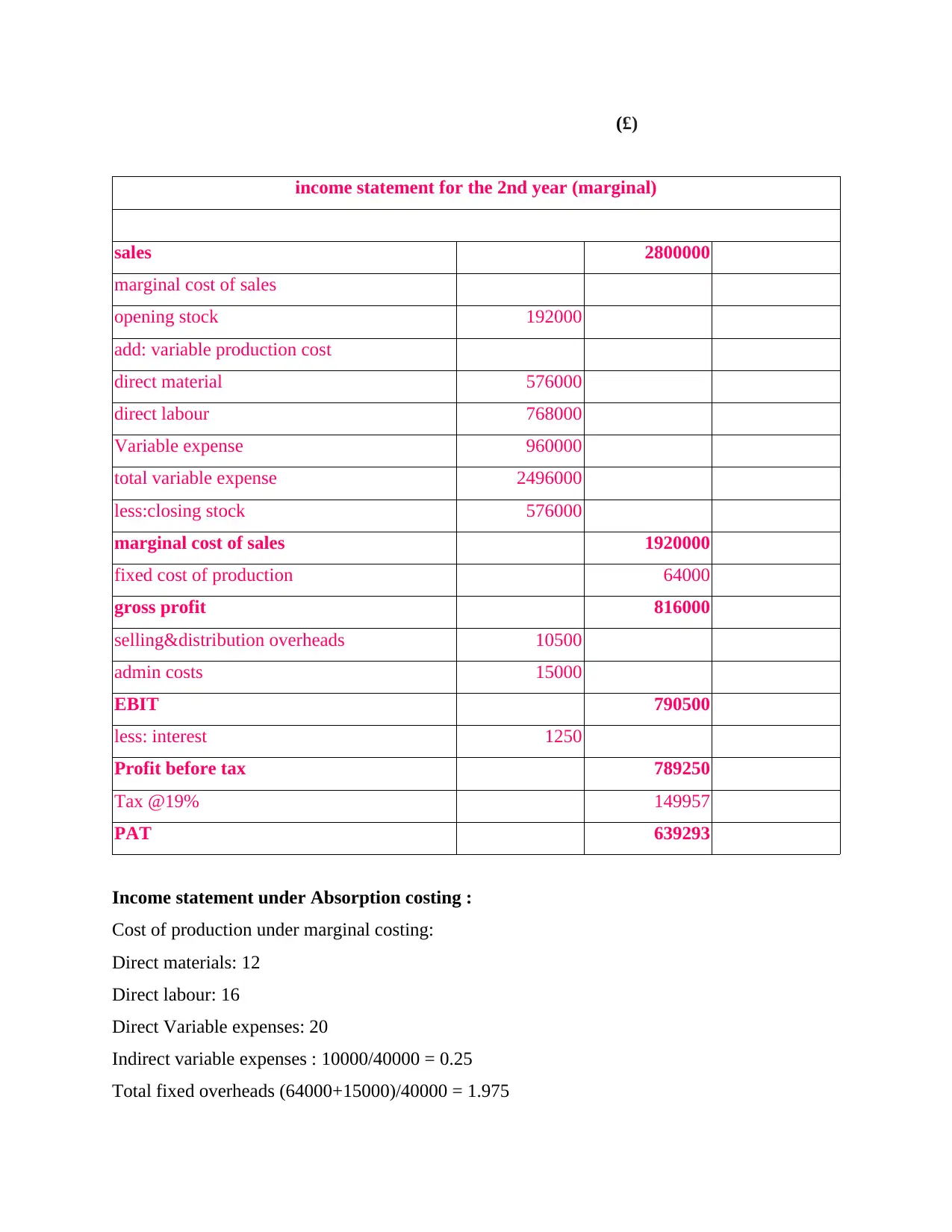
(£)
income statement for the 2nd year (marginal)
sales 2800000
marginal cost of sales
opening stock 192000
add: variable production cost
direct material 576000
direct labour 768000
Variable expense 960000
total variable expense 2496000
less:closing stock 576000
marginal cost of sales 1920000
fixed cost of production 64000
gross profit 816000
selling&distribution overheads 10500
admin costs 15000
EBIT 790500
less: interest 1250
Profit before tax 789250
Tax @19% 149957
PAT 639293
Income statement under Absorption costing :
Cost of production under marginal costing:
Direct materials: 12
Direct labour: 16
Direct Variable expenses: 20
Indirect variable expenses : 10000/40000 = 0.25
Total fixed overheads (64000+15000)/40000 = 1.975
income statement for the 2nd year (marginal)
sales 2800000
marginal cost of sales
opening stock 192000
add: variable production cost
direct material 576000
direct labour 768000
Variable expense 960000
total variable expense 2496000
less:closing stock 576000
marginal cost of sales 1920000
fixed cost of production 64000
gross profit 816000
selling&distribution overheads 10500
admin costs 15000
EBIT 790500
less: interest 1250
Profit before tax 789250
Tax @19% 149957
PAT 639293
Income statement under Absorption costing :
Cost of production under marginal costing:
Direct materials: 12
Direct labour: 16
Direct Variable expenses: 20
Indirect variable expenses : 10000/40000 = 0.25
Total fixed overheads (64000+15000)/40000 = 1.975
⊘ This is a preview!⊘
Do you want full access?
Subscribe today to unlock all pages.

Trusted by 1+ million students worldwide
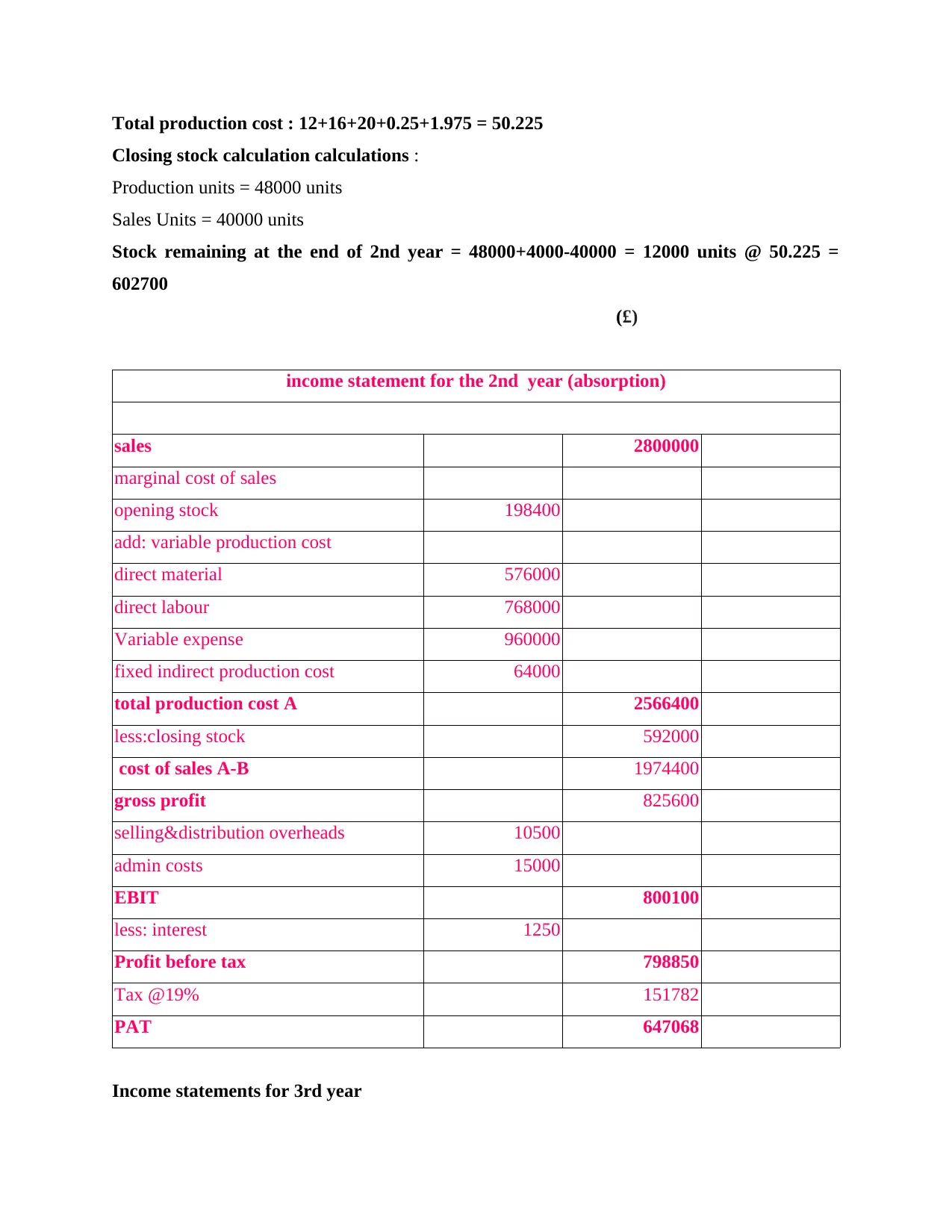
Total production cost : 12+16+20+0.25+1.975 = 50.225
Closing stock calculation calculations :
Production units = 48000 units
Sales Units = 40000 units
Stock remaining at the end of 2nd year = 48000+4000-40000 = 12000 units @ 50.225 =
602700
(£)
income statement for the 2nd year (absorption)
sales 2800000
marginal cost of sales
opening stock 198400
add: variable production cost
direct material 576000
direct labour 768000
Variable expense 960000
fixed indirect production cost 64000
total production cost A 2566400
less:closing stock 592000
cost of sales A-B 1974400
gross profit 825600
selling&distribution overheads 10500
admin costs 15000
EBIT 800100
less: interest 1250
Profit before tax 798850
Tax @19% 151782
PAT 647068
Income statements for 3rd year
Closing stock calculation calculations :
Production units = 48000 units
Sales Units = 40000 units
Stock remaining at the end of 2nd year = 48000+4000-40000 = 12000 units @ 50.225 =
602700
(£)
income statement for the 2nd year (absorption)
sales 2800000
marginal cost of sales
opening stock 198400
add: variable production cost
direct material 576000
direct labour 768000
Variable expense 960000
fixed indirect production cost 64000
total production cost A 2566400
less:closing stock 592000
cost of sales A-B 1974400
gross profit 825600
selling&distribution overheads 10500
admin costs 15000
EBIT 800100
less: interest 1250
Profit before tax 798850
Tax @19% 151782
PAT 647068
Income statements for 3rd year
Paraphrase This Document
Need a fresh take? Get an instant paraphrase of this document with our AI Paraphraser
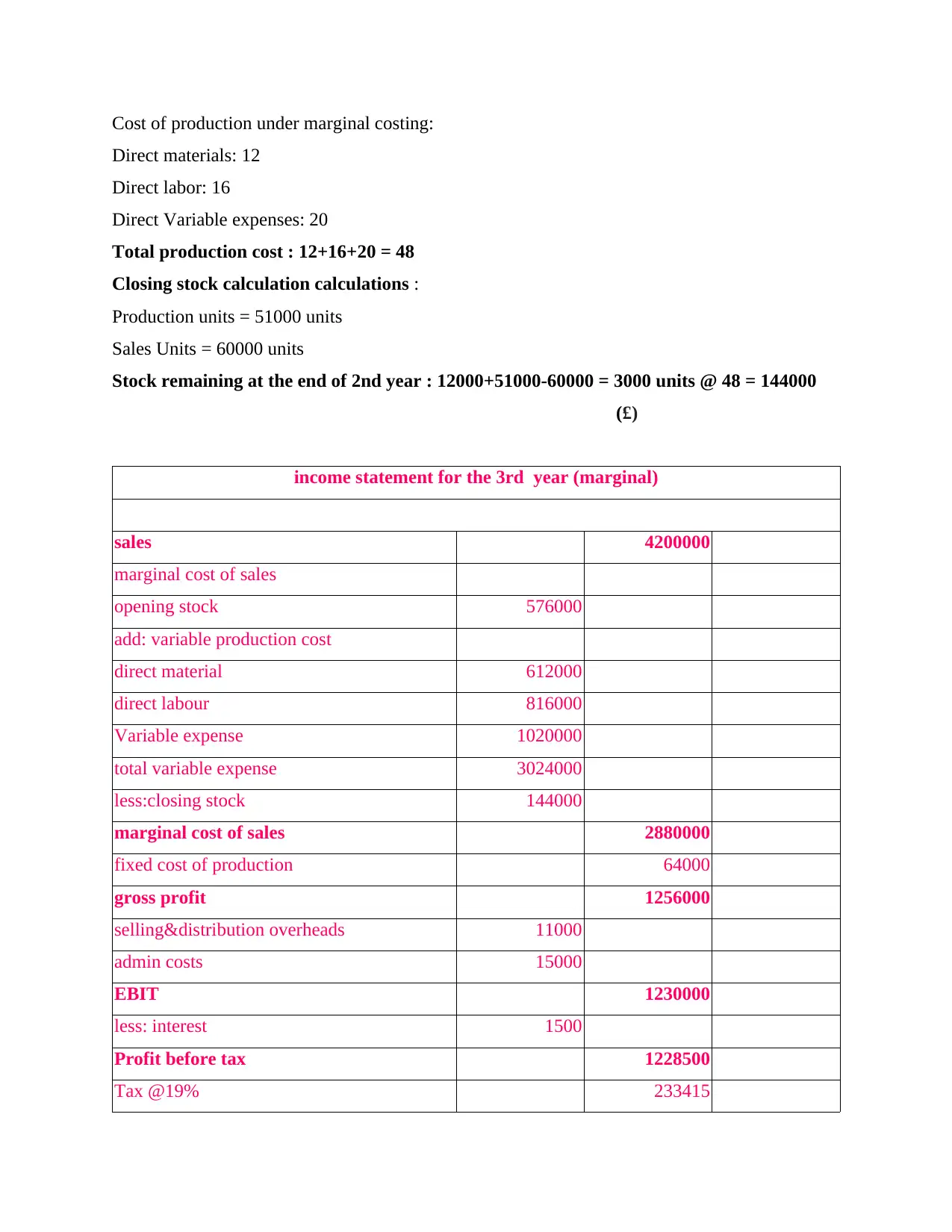
Cost of production under marginal costing:
Direct materials: 12
Direct labor: 16
Direct Variable expenses: 20
Total production cost : 12+16+20 = 48
Closing stock calculation calculations :
Production units = 51000 units
Sales Units = 60000 units
Stock remaining at the end of 2nd year : 12000+51000-60000 = 3000 units @ 48 = 144000
(£)
income statement for the 3rd year (marginal)
sales 4200000
marginal cost of sales
opening stock 576000
add: variable production cost
direct material 612000
direct labour 816000
Variable expense 1020000
total variable expense 3024000
less:closing stock 144000
marginal cost of sales 2880000
fixed cost of production 64000
gross profit 1256000
selling&distribution overheads 11000
admin costs 15000
EBIT 1230000
less: interest 1500
Profit before tax 1228500
Tax @19% 233415
Direct materials: 12
Direct labor: 16
Direct Variable expenses: 20
Total production cost : 12+16+20 = 48
Closing stock calculation calculations :
Production units = 51000 units
Sales Units = 60000 units
Stock remaining at the end of 2nd year : 12000+51000-60000 = 3000 units @ 48 = 144000
(£)
income statement for the 3rd year (marginal)
sales 4200000
marginal cost of sales
opening stock 576000
add: variable production cost
direct material 612000
direct labour 816000
Variable expense 1020000
total variable expense 3024000
less:closing stock 144000
marginal cost of sales 2880000
fixed cost of production 64000
gross profit 1256000
selling&distribution overheads 11000
admin costs 15000
EBIT 1230000
less: interest 1500
Profit before tax 1228500
Tax @19% 233415
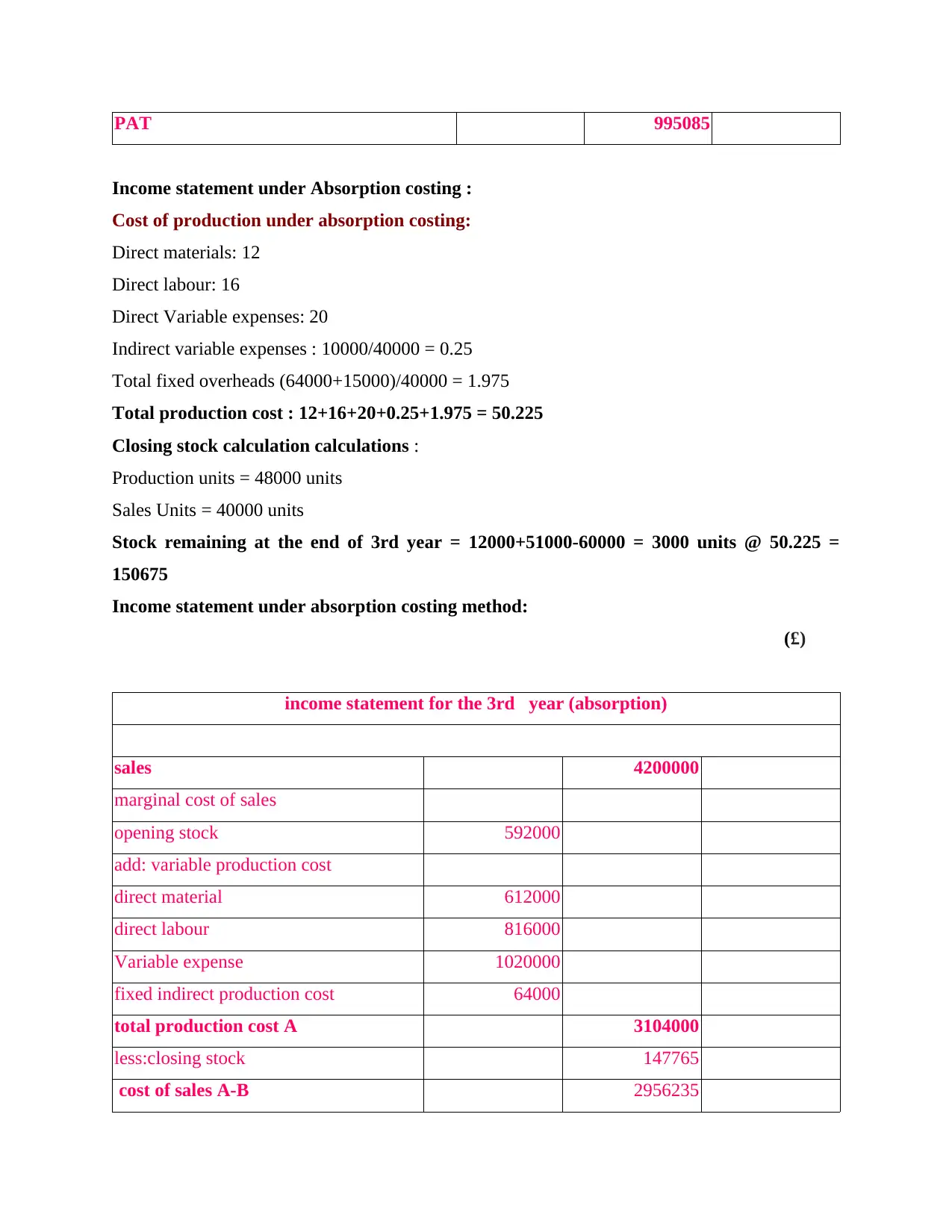
PAT 995085
Income statement under Absorption costing :
Cost of production under absorption costing:
Direct materials: 12
Direct labour: 16
Direct Variable expenses: 20
Indirect variable expenses : 10000/40000 = 0.25
Total fixed overheads (64000+15000)/40000 = 1.975
Total production cost : 12+16+20+0.25+1.975 = 50.225
Closing stock calculation calculations :
Production units = 48000 units
Sales Units = 40000 units
Stock remaining at the end of 3rd year = 12000+51000-60000 = 3000 units @ 50.225 =
150675
Income statement under absorption costing method:
(£)
income statement for the 3rd year (absorption)
sales 4200000
marginal cost of sales
opening stock 592000
add: variable production cost
direct material 612000
direct labour 816000
Variable expense 1020000
fixed indirect production cost 64000
total production cost A 3104000
less:closing stock 147765
cost of sales A-B 2956235
Income statement under Absorption costing :
Cost of production under absorption costing:
Direct materials: 12
Direct labour: 16
Direct Variable expenses: 20
Indirect variable expenses : 10000/40000 = 0.25
Total fixed overheads (64000+15000)/40000 = 1.975
Total production cost : 12+16+20+0.25+1.975 = 50.225
Closing stock calculation calculations :
Production units = 48000 units
Sales Units = 40000 units
Stock remaining at the end of 3rd year = 12000+51000-60000 = 3000 units @ 50.225 =
150675
Income statement under absorption costing method:
(£)
income statement for the 3rd year (absorption)
sales 4200000
marginal cost of sales
opening stock 592000
add: variable production cost
direct material 612000
direct labour 816000
Variable expense 1020000
fixed indirect production cost 64000
total production cost A 3104000
less:closing stock 147765
cost of sales A-B 2956235
⊘ This is a preview!⊘
Do you want full access?
Subscribe today to unlock all pages.

Trusted by 1+ million students worldwide
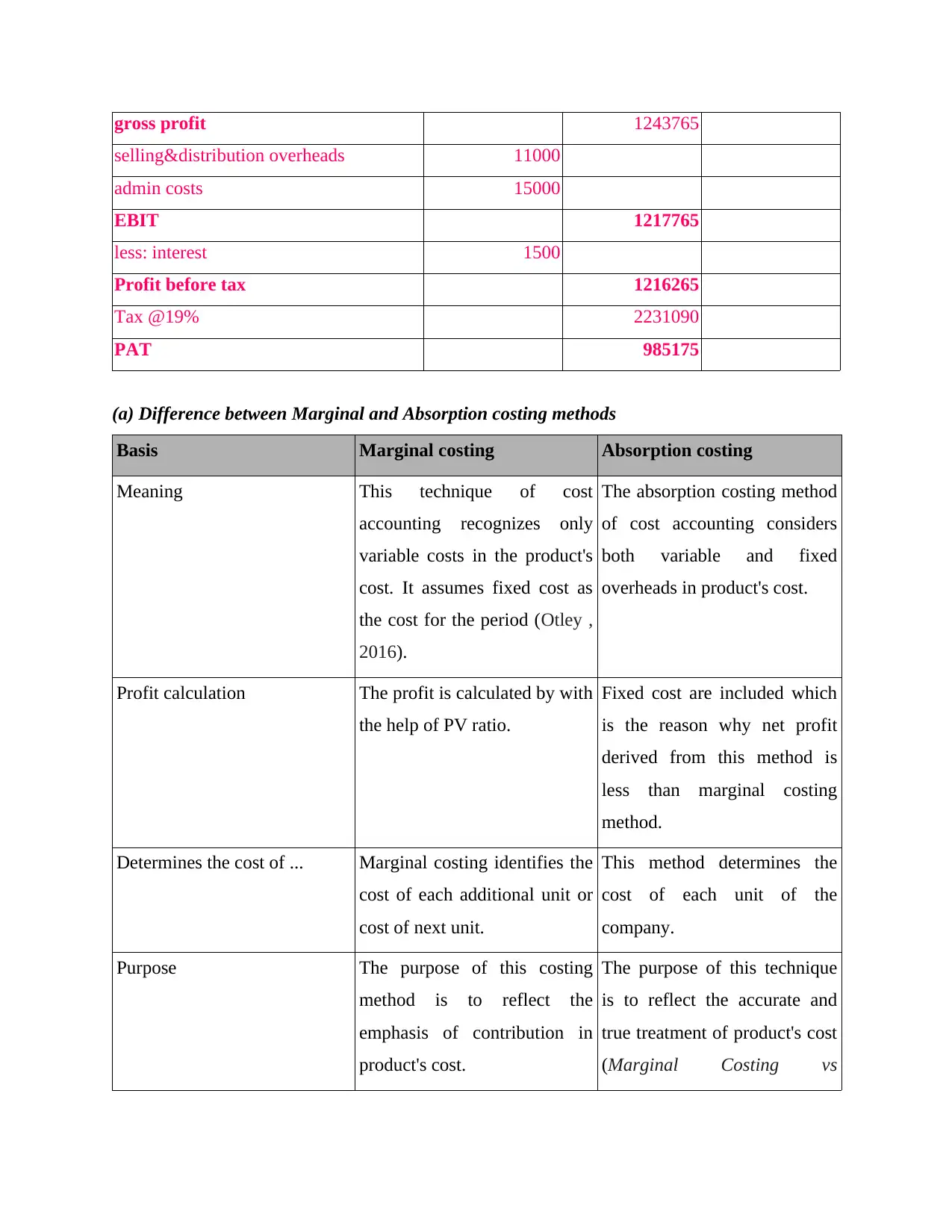
gross profit 1243765
selling&distribution overheads 11000
admin costs 15000
EBIT 1217765
less: interest 1500
Profit before tax 1216265
Tax @19% 2231090
PAT 985175
(a) Difference between Marginal and Absorption costing methods
Basis Marginal costing Absorption costing
Meaning This technique of cost
accounting recognizes only
variable costs in the product's
cost. It assumes fixed cost as
the cost for the period (Otley ,
2016).
The absorption costing method
of cost accounting considers
both variable and fixed
overheads in product's cost.
Profit calculation The profit is calculated by with
the help of PV ratio.
Fixed cost are included which
is the reason why net profit
derived from this method is
less than marginal costing
method.
Determines the cost of ... Marginal costing identifies the
cost of each additional unit or
cost of next unit.
This method determines the
cost of each unit of the
company.
Purpose The purpose of this costing
method is to reflect the
emphasis of contribution in
product's cost.
The purpose of this technique
is to reflect the accurate and
true treatment of product's cost
(Marginal Costing vs
selling&distribution overheads 11000
admin costs 15000
EBIT 1217765
less: interest 1500
Profit before tax 1216265
Tax @19% 2231090
PAT 985175
(a) Difference between Marginal and Absorption costing methods
Basis Marginal costing Absorption costing
Meaning This technique of cost
accounting recognizes only
variable costs in the product's
cost. It assumes fixed cost as
the cost for the period (Otley ,
2016).
The absorption costing method
of cost accounting considers
both variable and fixed
overheads in product's cost.
Profit calculation The profit is calculated by with
the help of PV ratio.
Fixed cost are included which
is the reason why net profit
derived from this method is
less than marginal costing
method.
Determines the cost of ... Marginal costing identifies the
cost of each additional unit or
cost of next unit.
This method determines the
cost of each unit of the
company.
Purpose The purpose of this costing
method is to reflect the
emphasis of contribution in
product's cost.
The purpose of this technique
is to reflect the accurate and
true treatment of product's cost
(Marginal Costing vs
Paraphrase This Document
Need a fresh take? Get an instant paraphrase of this document with our AI Paraphraser
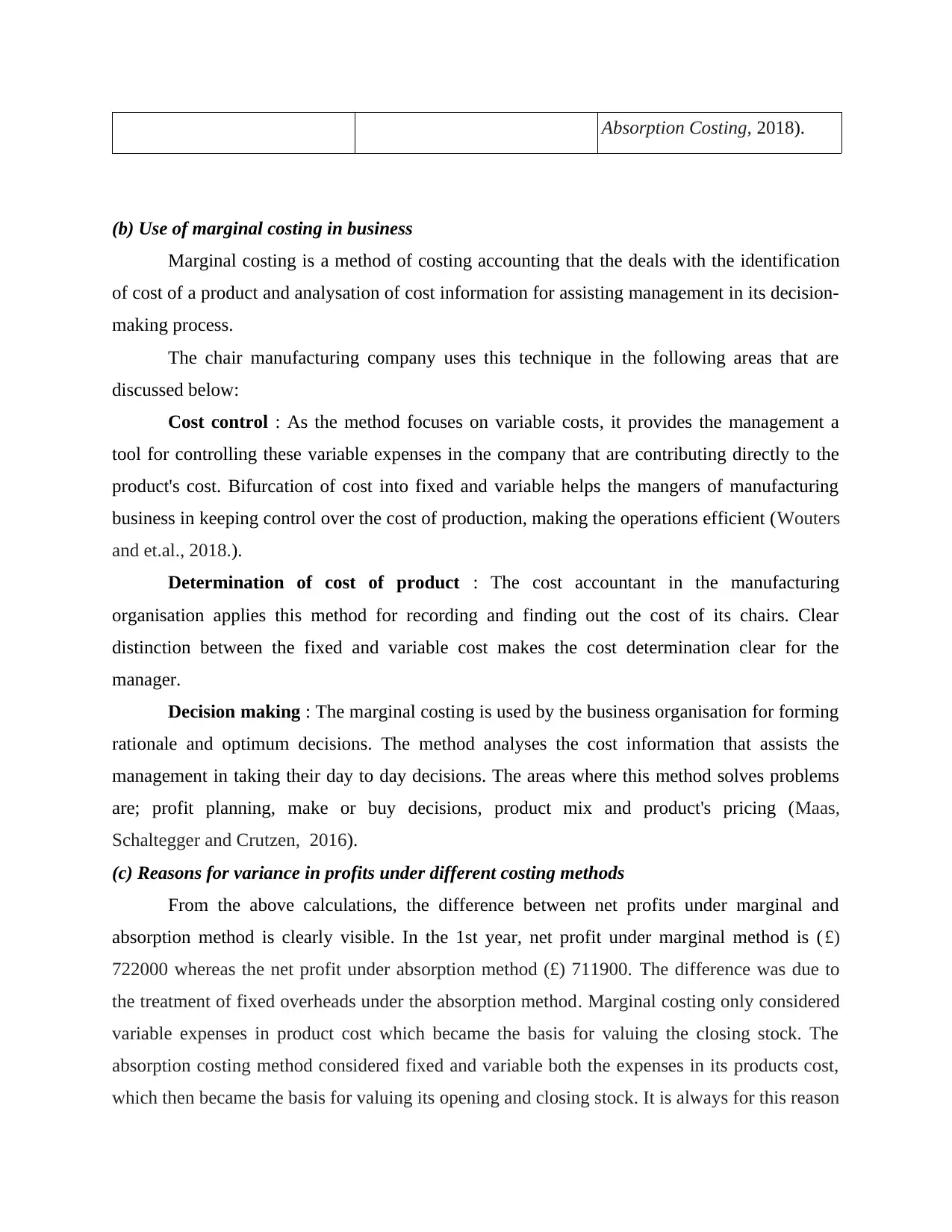
Absorption Costing, 2018).
(b) Use of marginal costing in business
Marginal costing is a method of costing accounting that the deals with the identification
of cost of a product and analysation of cost information for assisting management in its decision-
making process.
The chair manufacturing company uses this technique in the following areas that are
discussed below:
Cost control : As the method focuses on variable costs, it provides the management a
tool for controlling these variable expenses in the company that are contributing directly to the
product's cost. Bifurcation of cost into fixed and variable helps the mangers of manufacturing
business in keeping control over the cost of production, making the operations efficient (Wouters
and et.al., 2018.).
Determination of cost of product : The cost accountant in the manufacturing
organisation applies this method for recording and finding out the cost of its chairs. Clear
distinction between the fixed and variable cost makes the cost determination clear for the
manager.
Decision making : The marginal costing is used by the business organisation for forming
rationale and optimum decisions. The method analyses the cost information that assists the
management in taking their day to day decisions. The areas where this method solves problems
are; profit planning, make or buy decisions, product mix and product's pricing (Maas,
Schaltegger and Crutzen, 2016).
(c) Reasons for variance in profits under different costing methods
From the above calculations, the difference between net profits under marginal and
absorption method is clearly visible. In the 1st year, net profit under marginal method is (£)
722000 whereas the net profit under absorption method (£) 711900. The difference was due to
the treatment of fixed overheads under the absorption method. Marginal costing only considered
variable expenses in product cost which became the basis for valuing the closing stock. The
absorption costing method considered fixed and variable both the expenses in its products cost,
which then became the basis for valuing its opening and closing stock. It is always for this reason
(b) Use of marginal costing in business
Marginal costing is a method of costing accounting that the deals with the identification
of cost of a product and analysation of cost information for assisting management in its decision-
making process.
The chair manufacturing company uses this technique in the following areas that are
discussed below:
Cost control : As the method focuses on variable costs, it provides the management a
tool for controlling these variable expenses in the company that are contributing directly to the
product's cost. Bifurcation of cost into fixed and variable helps the mangers of manufacturing
business in keeping control over the cost of production, making the operations efficient (Wouters
and et.al., 2018.).
Determination of cost of product : The cost accountant in the manufacturing
organisation applies this method for recording and finding out the cost of its chairs. Clear
distinction between the fixed and variable cost makes the cost determination clear for the
manager.
Decision making : The marginal costing is used by the business organisation for forming
rationale and optimum decisions. The method analyses the cost information that assists the
management in taking their day to day decisions. The areas where this method solves problems
are; profit planning, make or buy decisions, product mix and product's pricing (Maas,
Schaltegger and Crutzen, 2016).
(c) Reasons for variance in profits under different costing methods
From the above calculations, the difference between net profits under marginal and
absorption method is clearly visible. In the 1st year, net profit under marginal method is (£)
722000 whereas the net profit under absorption method (£) 711900. The difference was due to
the treatment of fixed overheads under the absorption method. Marginal costing only considered
variable expenses in product cost which became the basis for valuing the closing stock. The
absorption costing method considered fixed and variable both the expenses in its products cost,
which then became the basis for valuing its opening and closing stock. It is always for this reason
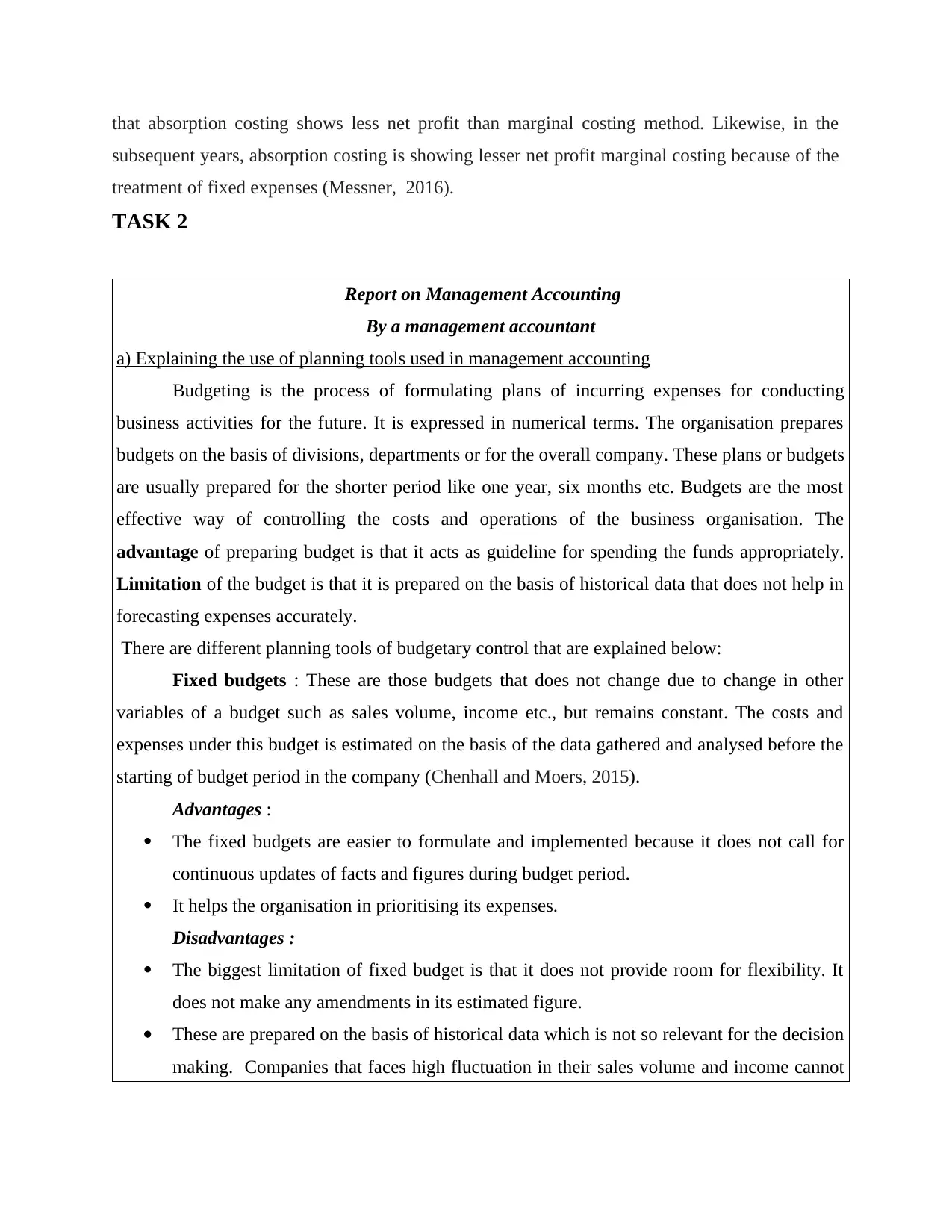
that absorption costing shows less net profit than marginal costing method. Likewise, in the
subsequent years, absorption costing is showing lesser net profit marginal costing because of the
treatment of fixed expenses (Messner, 2016).
TASK 2
Report on Management Accounting
By a management accountant
a) Explaining the use of planning tools used in management accounting
Budgeting is the process of formulating plans of incurring expenses for conducting
business activities for the future. It is expressed in numerical terms. The organisation prepares
budgets on the basis of divisions, departments or for the overall company. These plans or budgets
are usually prepared for the shorter period like one year, six months etc. Budgets are the most
effective way of controlling the costs and operations of the business organisation. The
advantage of preparing budget is that it acts as guideline for spending the funds appropriately.
Limitation of the budget is that it is prepared on the basis of historical data that does not help in
forecasting expenses accurately.
There are different planning tools of budgetary control that are explained below:
Fixed budgets : These are those budgets that does not change due to change in other
variables of a budget such as sales volume, income etc., but remains constant. The costs and
expenses under this budget is estimated on the basis of the data gathered and analysed before the
starting of budget period in the company (Chenhall and Moers, 2015).
Advantages :
The fixed budgets are easier to formulate and implemented because it does not call for
continuous updates of facts and figures during budget period.
It helps the organisation in prioritising its expenses.
Disadvantages :
The biggest limitation of fixed budget is that it does not provide room for flexibility. It
does not make any amendments in its estimated figure.
These are prepared on the basis of historical data which is not so relevant for the decision
making. Companies that faces high fluctuation in their sales volume and income cannot
subsequent years, absorption costing is showing lesser net profit marginal costing because of the
treatment of fixed expenses (Messner, 2016).
TASK 2
Report on Management Accounting
By a management accountant
a) Explaining the use of planning tools used in management accounting
Budgeting is the process of formulating plans of incurring expenses for conducting
business activities for the future. It is expressed in numerical terms. The organisation prepares
budgets on the basis of divisions, departments or for the overall company. These plans or budgets
are usually prepared for the shorter period like one year, six months etc. Budgets are the most
effective way of controlling the costs and operations of the business organisation. The
advantage of preparing budget is that it acts as guideline for spending the funds appropriately.
Limitation of the budget is that it is prepared on the basis of historical data that does not help in
forecasting expenses accurately.
There are different planning tools of budgetary control that are explained below:
Fixed budgets : These are those budgets that does not change due to change in other
variables of a budget such as sales volume, income etc., but remains constant. The costs and
expenses under this budget is estimated on the basis of the data gathered and analysed before the
starting of budget period in the company (Chenhall and Moers, 2015).
Advantages :
The fixed budgets are easier to formulate and implemented because it does not call for
continuous updates of facts and figures during budget period.
It helps the organisation in prioritising its expenses.
Disadvantages :
The biggest limitation of fixed budget is that it does not provide room for flexibility. It
does not make any amendments in its estimated figure.
These are prepared on the basis of historical data which is not so relevant for the decision
making. Companies that faces high fluctuation in their sales volume and income cannot
⊘ This is a preview!⊘
Do you want full access?
Subscribe today to unlock all pages.

Trusted by 1+ million students worldwide
1 out of 20
Related Documents
Your All-in-One AI-Powered Toolkit for Academic Success.
+13062052269
info@desklib.com
Available 24*7 on WhatsApp / Email
![[object Object]](/_next/static/media/star-bottom.7253800d.svg)
Unlock your academic potential
Copyright © 2020–2025 A2Z Services. All Rights Reserved. Developed and managed by ZUCOL.





